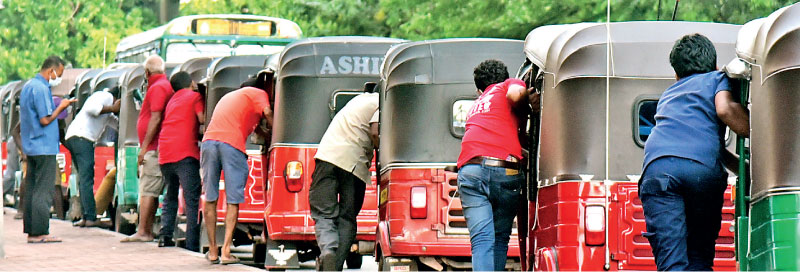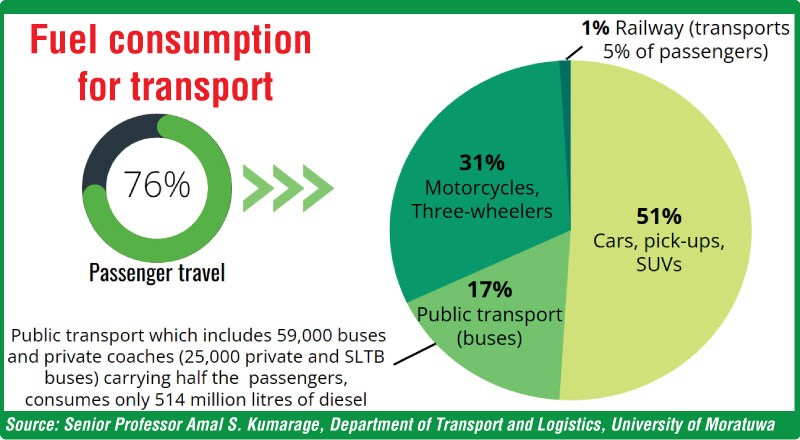Sunday Apr 20, 2025
Sunday Apr 20, 2025
Monday, 25 July 2022 00:14 - - {{hitsCtrl.values.hits}}

 To every problem there is a solution. The reason why we sometimes feel there isn’t one or one cannot be found, is because we are unwilling to look for answers by accepting our reality. There is also the need to accept that there is a problem. If we ignore the problem and its root causes, we will never be able to find the solution and instead will only grope in the dark, trying to band-aid our way out of it…
To every problem there is a solution. The reason why we sometimes feel there isn’t one or one cannot be found, is because we are unwilling to look for answers by accepting our reality. There is also the need to accept that there is a problem. If we ignore the problem and its root causes, we will never be able to find the solution and instead will only grope in the dark, trying to band-aid our way out of it…
Right now, we are faced with a massive shortage of fuel in the country and we need to accept that only a limited supply can come into the system. Going by what is being said in the media and the Central Bank, it would be fair to assume that only one-third of our fuel demand is being met. The reality therefore is that it is all our economy can currently afford. On top of that the Central Bank Governor in his most recent statement to the media has said that Sri Lanka will not receive any bridge financing until an IMF program is confirmed. He says we will have to manage imports with dollar inflows that are available to us.
Given all this, it is fair to admit that the situation is serious — not merely in terms of meeting lifestyles of the populace, especially those in the urban sector, but more in the direction of sustaining the entire economy, so it wouldn’t falter and end in total economic collapse.
How do we figure out a solution to this very pressing problem? First, by looking at the way in which fuel was consumed in the country up until now. An analysis done by Senior Professor Amal S. Kumarage, Department of Transport and Logistics, University of Moratuwa says, 63% out of our total fuel consumption bill was for road transport. Of that 31% went for motorcycles and three-wheelers, 17% for public road transport i.e. buses, 1% for railway transport and 51% for cars, pickups and SUVs. So the question arises as to how we can manage the limited amount of fuel we now have taking these numbers into account. How do we prioritise and what is the criteria?
Prioritising a must
There is absolutely no doubt that what needs to take precedence today is what supports direct economic activity and how much of it must go towards supporting the bottom of the pyramid. We have to ensure human movement to keep our internal/local economy oiled and functioning. This is a fundamental principle in modern day urban living. But the opposite of it is happening in Sri Lanka today where the fuel crisis is gradually turning our big cities into ghost towns. The disruption it has caused is snowballing into severely impacting the GDP of provinces. If we are to arrest this situation as we must, it is vital to have a plan that prioritises fuel consumption for transportation and there is no argument it has to start with public transport. Mass transportation systems like buses and train travel need to be strengthened to take the bulk of the volumes. Parallel to this, we need to position the second tier i.e. two and three-wheeler travel. This will bolster economic activity in the last 3 to 1 kilometre ranges of our homes.
In doing this however, some difficult decisions have to be made. In prioritising fuel distribution, buses and trains have to come first under mass transport; and three-wheelers and two-wheelers as the secondary level of public transport. With the limited supply of fuel coming into the system, we need foolproof methods of ensuring that fuel distribution to the secondary level of public transport is used in a transparent manner so that it does not account for a black market which will only go against the productivity levels of the provinces.
Transparency and digitalisation
Digitalisation is the best solution to this. It is a clear and transparent way of ensuring that fuel is supplied to the system not only equally, but in an equitable and productive way. The argument for supplying fuel to two and three-wheelers as the second tier is pegged on their being connected to economic activities such as moving people and goods. Another reason is that it provides direct employment to the bottom of the pyramid, in turn, supporting close on 4-5 million citizens economically. Unlike private transportation, three and two-wheelers ensure more trips per vehicle and invariably these vehicles are more fuel efficient than four-wheelers, which naturally increases their productivity levels.
Pilot program with digital operators
Given this, it is worthwhile for the Ministry of Transport with the support of the Energy Ministry to run a pilot program with digital taxi hailing services. These companies would be able to create another layer in their software platforms to monitor mileage/hires and the efficient usage of petrol.
If 10,000 three-wheelers are given an 80,000 litre quota, they can do approximately 200,000 trips around the city, moving around 400,000 passengers in a day. We can monitor this through our software to ensure accuracy and transparency and can even be subject to an audit. The system we propose will be directly tied to the amount of mileage our tuks do, and if we find the set criteria is not met, then we would immediately take those drivers off the system.
Digital companies can also serve another important purpose in supporting the economy of our provinces, by acting as a benchmark for standardised fares. This will prevent volatility in the market and prevent unscrupulous elements from charging exorbitant rates for citizen travel. The assurance of a steady fuel supply earmarking two and three-wheelers dedicated to servicing provincial economic activities through deliveries and passenger transport, will have a definite positive impact. Therefore such vehicles open to being monitored and scrutinised in their use of fuel and mileage should be given priority at fuel pumps.
Opportunity cost and standardising
There have been several complaints recently by city travellers of exorbitant rates being charged by three-wheelers. But these prices have to be viewed from the perspective of the current prices of fuel and more, from the days spent in queues to obtain that fuel, which is being quantified and added on to the fares as opportunity costs. In order to reduce or do away with these opportunity costs, three and two-wheelers should be given the necessary priority, albeit connected to a transparent system of monitoring i.e. digital ride hailing companies. This will enable them to benchmark and ensure standardised fares, which will ease the load of the ordinary traveller.
On a wider canvas, state agencies would bear the responsibility of monitoring these digitised companies and auditing them for data analysis and decision making.
Need to get it right
There is an urgent need for rationalising the usage of fuel. There is no doubt that we have been squandering our limited resources and that is because we did not understand the economic conditions of our country. Transport and the movement of goods and passengers are important economic activities that cannot be ignored. If we get this right, a large part of our problems will be solved.
